8.03 Blood Vessels
Key Blood Vessel Types
- Artery
- Characteristics:
- Thick, elastic walls
- Carries high-pressure blood away from the heart
- Examples:
- Elastic arteries (e.g., aorta)
- Muscular arteries (e.g., femoral artery)
- Characteristics:
- Vein
- Characteristics:
- Thinner walls compared to arteries
- Carries low-pressure blood towards the heart
- Contains semilunar valves to prevent backflow
- Examples:
- Superficial veins (e.g., cephalic vein)
- Deep veins (e.g., vena cava)
- Characteristics:
- Arteriole
- Characteristics:
- Small branches of arteries
- Controls blood flow to capillaries
- Narrow diameter increases resistance and regulates blood pressure
- Function:
- Facilitates regulation of blood flow via vasoconstriction and vasodilation
- Characteristics:
- Venule
- Characteristics:
- Small veins collecting blood from capillaries
- Converge to form larger veins
- Function:
- Transport deoxygenated blood from capillary beds to larger veins
- Characteristics:
- Capillary
- Characteristics:
- Tiny diameter (~7 μm)
- Single-layer endothelium composed of squamous epithelial cells
- Function:
- Facilitates exchange of oxygen, nutrients, and waste between blood and tissues
- Capillary beds form extensive networks within most body tissues
- Characteristics:
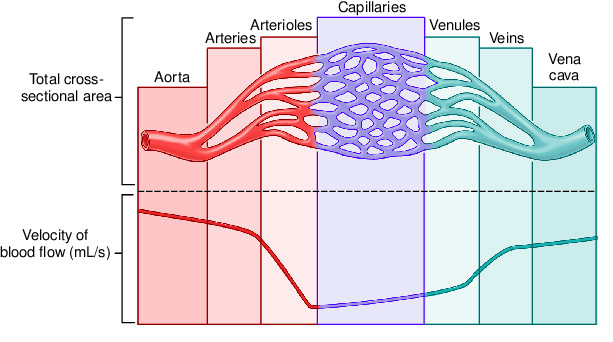
Structure and Function of Blood Vessels
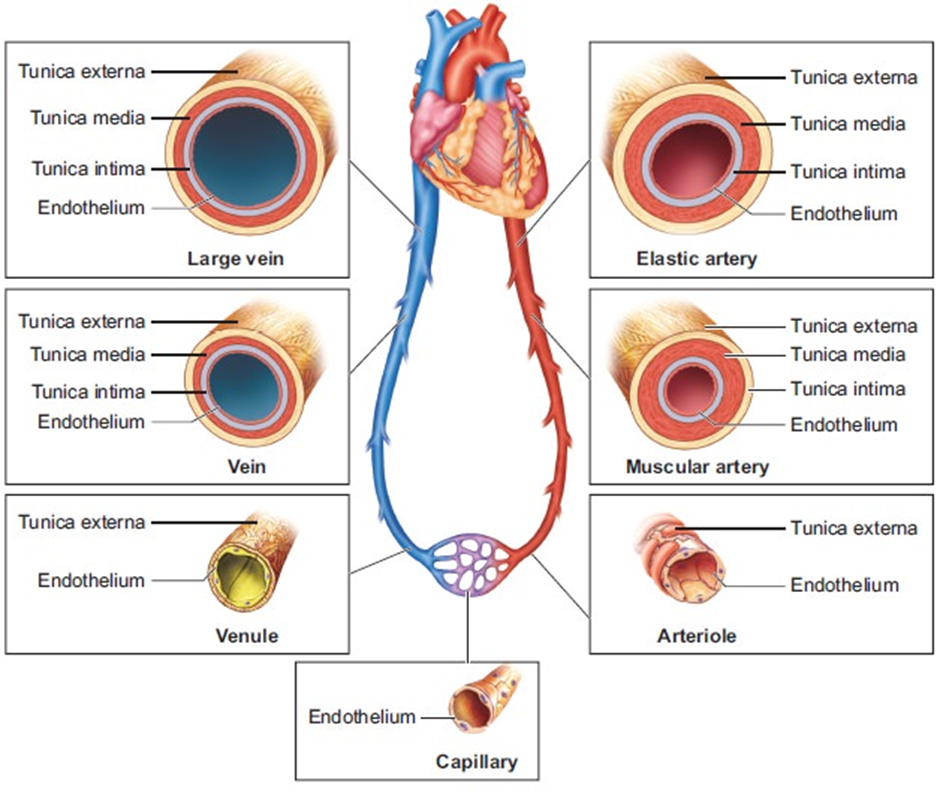
Arteries
- Purpose:
- Transport high-pressure blood swiftly to various tissues and organs
- Structure:
- Three Layers:
- Inner Layer (Tunica Intima):
- Composed of endothelium (smooth lining to reduce friction)
- Contains elastic fibers for flexibility
- Middle Layer (Tunica Media):
- Thickest layer
- Rich in smooth muscle, elastic fibers, and collagen (
- Outer Layer (Tunica Externa):
- Composed mainly of collagen and some elastic fibers. (Collagen is the most abundant protein in the human body. It is found in skin, bones, tendons, ligaments, and many other tissues. It provides tensile strength and structure, working alongside other proteins (like elastin) and glycoproteins in the extracellular matrix.)
- (Tensile strength: a measure of the maximum amount of tension (pulling or stretching force) a material can withstand without breaking).
- Inner Layer (Tunica Intima):
- Three Layers:
- Elasticity:
- Function:
- Maintains blood pressure by allowing walls to stretch and recoil
- Helps moderate blood flow during heartbeats
- Function:
- Types of Arteries:
- Elastic Arteries:
- Located near the heart (e.g., aorta)
- Higher proportion of elastic fibers to withstand and absorb high pressure
- Muscular Arteries:
- Located closer to tissues and organs
- Higher proportion of smooth muscle to control vessel diameter through vasoconstriction and vasodilation
- Elastic Arteries:
Arterioles
- Role:
- Serve as the transition from arteries to capillaries
- Control blood flow into capillary networks
- Characteristics:
- Narrow diameter increases vascular resistance
- Smooth muscle allows regulation of blood flow and blood pressure via contraction and relaxation
Capillaries
- Function:
- Site of exchange for oxygen, nutrients, and waste products between blood and tissues
- Structure:
- Single-Layer Endothelium:
- Made of squamous epithelial cells to facilitate efficient diffusion
- Diameter:
- Approximately 7 μm, allowing red blood cells to pass closely to tissue cells
- Capillary Beds:
- Extensive networks found in most tissues (except cornea, cartilage, and certain areas of the brain)
- Single-Layer Endothelium:
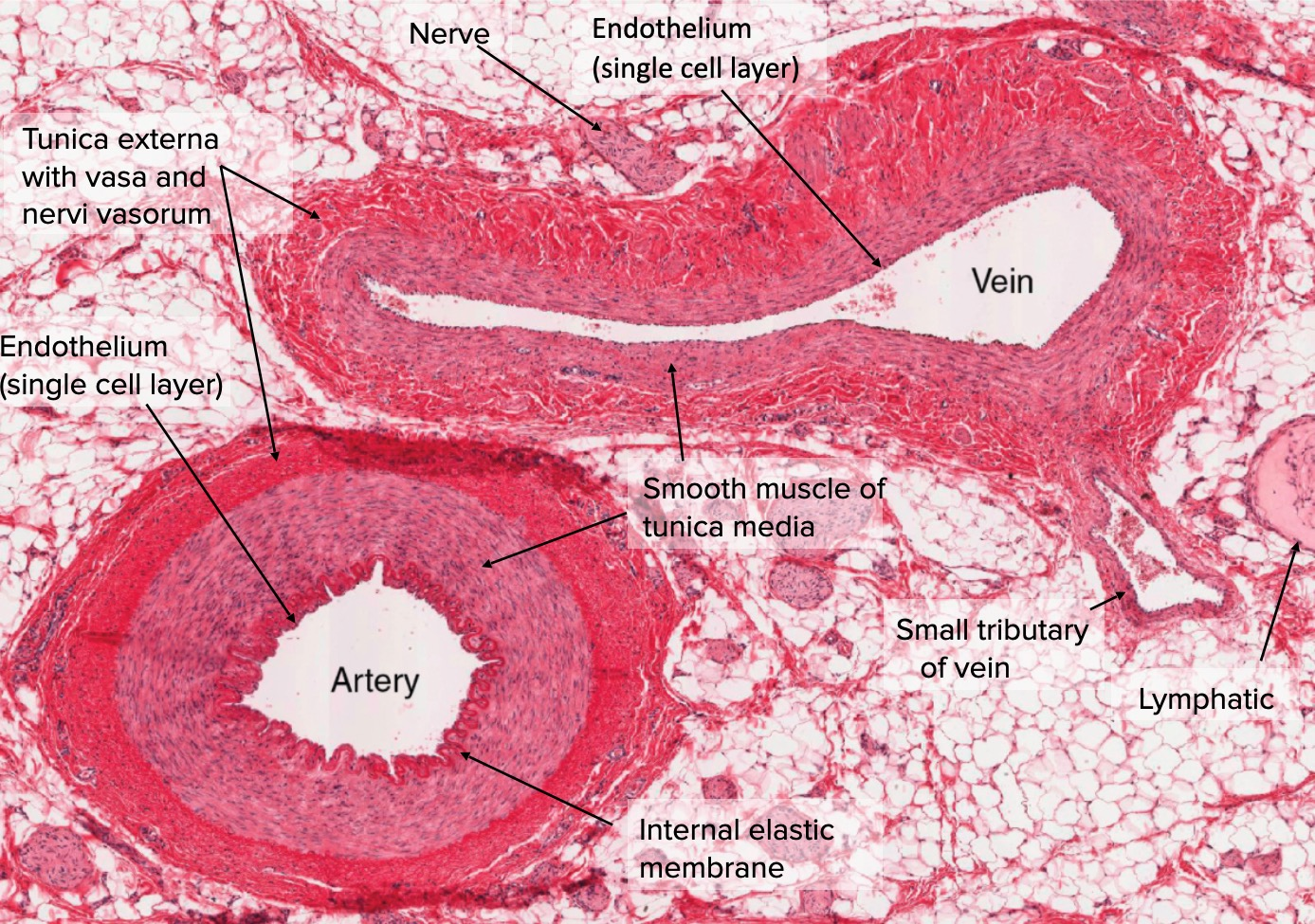
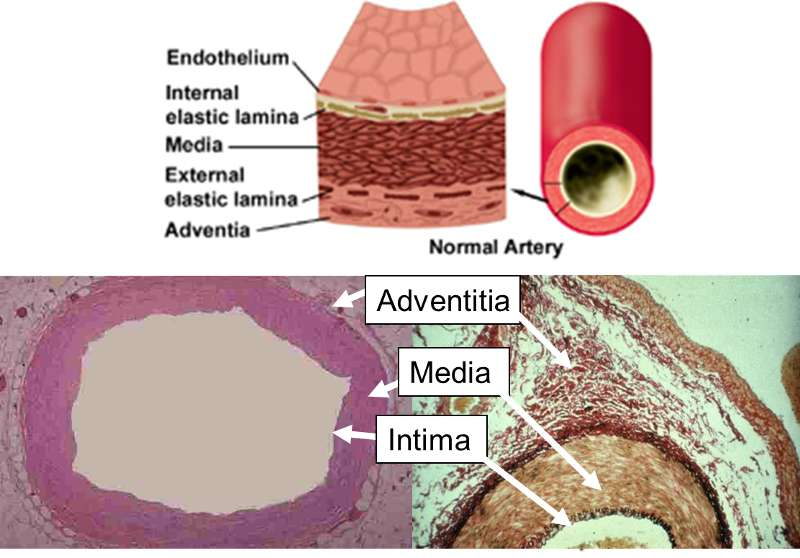
Veins and Venules
- Purpose:
- Return deoxygenated, low-pressure blood back to the heart.
- Structure:
- Three Layers (Similar to Arteries):
- Inner Layer (Tunica Intima)
- Middle Layer (Tunica Media)
- Much thinner than in arteries
- Outer Layer (Tunica Externa)
- Semilunar Valves:
- Prevent backflow of blood, ensuring unidirectional flow towards the heart.
- Muscle Assistance:
- Veins near muscles (e.g., in legs) utilize muscle contractions to help propel blood against gravity.
- Three Layers (Similar to Arteries):

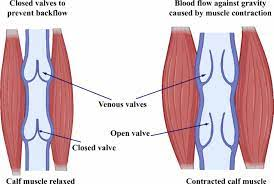
Blood Pressure in the Circulatory System
Systemic vs. Pulmonary Pressure
- Systemic Circulation:
- Pressure: Higher
- Function: Supplies oxygenated blood to the entire body
- Pulmonary Circulation:
- Pressure: Lower
- Function: Transfers blood between the heart and lungs, protecting delicate lung tissues from high pressure
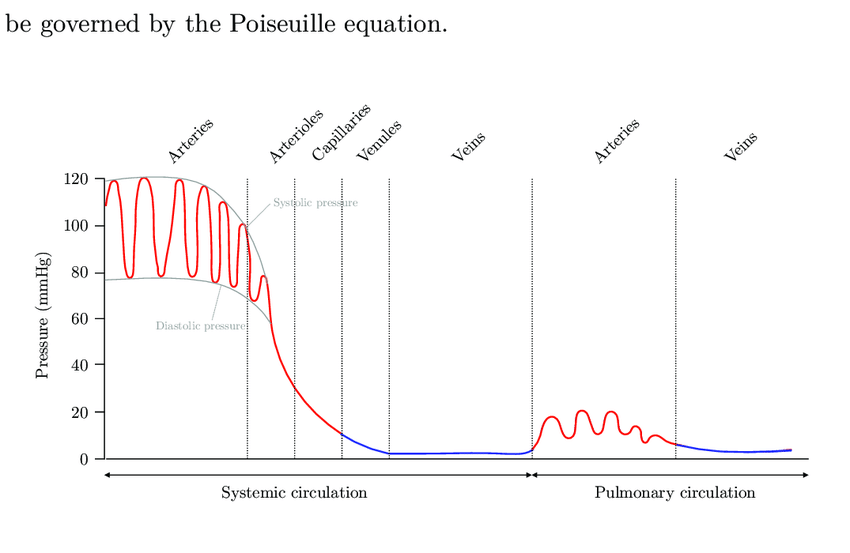
Pressure Gradients
- Arteries:
- Start with high pressure from the heart
- Pressure decreases progressively through smaller arteries and arterioles
- Capillaries:
- Exhibit moderate pressure
- Allows sufficient time for gas and nutrient exchange
- Veins:
- Feature low pressure
- Blood flow is slow, assisted by muscle contractions and valve mechanisms
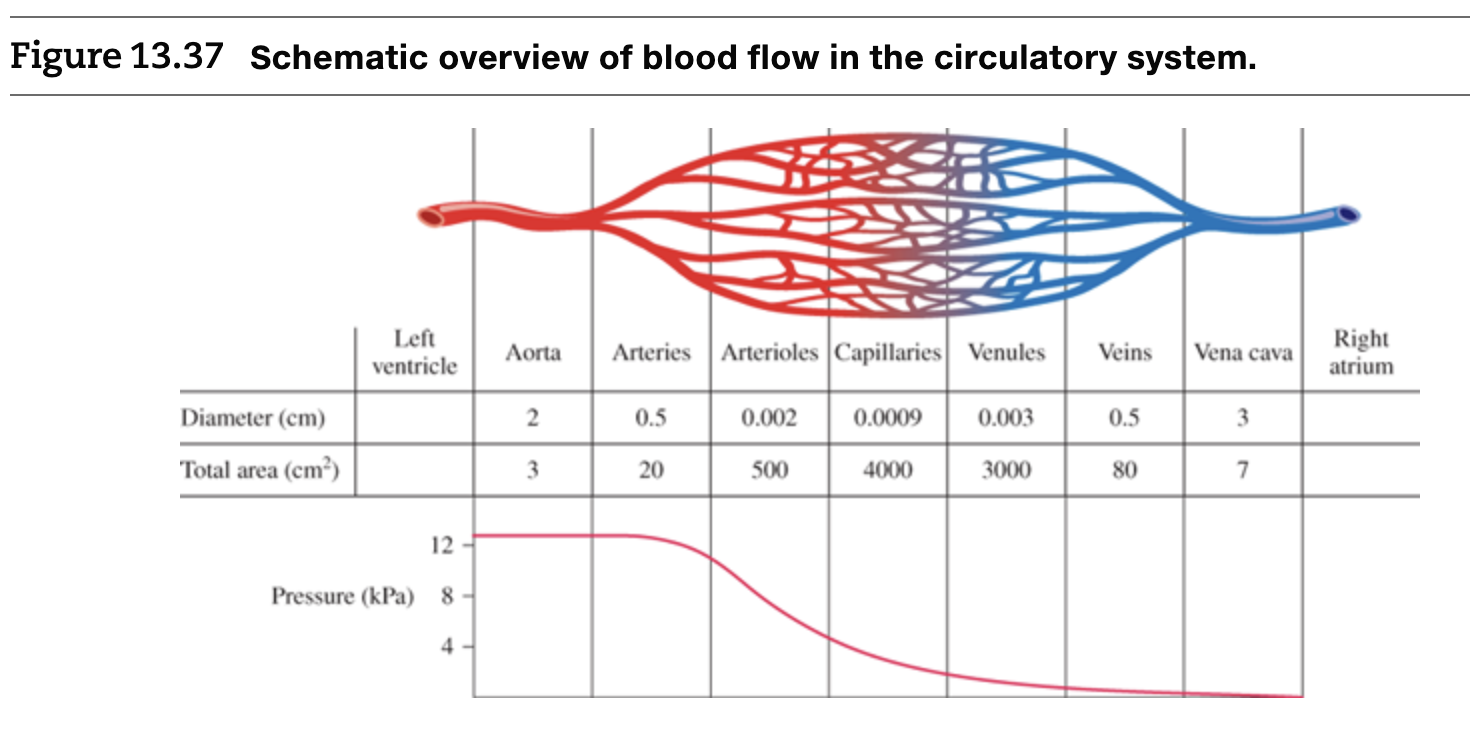
Key Vocabulary
- Endothelium:
- The innermost lining of blood vessels, composed of smooth cells to facilitate blood flow
- Squamous Epithelium:
- Flat, scale-like cells lining capillaries, enabling efficient diffusion of substances
- Smooth Muscle:
- Type of muscle found in vessel walls that contracts slowly and maintains long-term regulation of blood vessel diameter
- Elastic Arteries:
- Large arteries with abundant elastic tissue, designed to handle the high-pressure output from the heart
- Muscular Arteries:
- Arteries with a greater concentration of smooth muscle, allowing precise control over blood distribution to various tissues
- Vasoconstriction:
- The narrowing of blood vessels due to contraction of smooth muscle, increasing vascular resistance and blood pressure
- Vasodilation:
- The widening of blood vessels due to relaxation of smooth muscle, decreasing vascular resistance and blood pressure
- Semilunar Valve:
- Valves located in veins and the heart’s ventricles that prevent the backflow of blood, ensuring it moves in the correct direction
Practice Questions
Question 1
Describe the structural differences between arteries and veins. (5 marks)
- Wall Thickness:
- Arteries have thicker walls compared to veins due to a higher concentration of smooth muscle and elastic fibers. (1 mark)
- Wall Layers:
- Arteries consist of three layers: Tunica Intima, Tunica Media, and Tunica Externa with a thick Tunica Media. (1 mark)
- Veins also have three layers but with a thinner Tunica Media and a more prominent Tunica Externa. (1 mark)
- Elasticity and Flexibility:
- Arteries are more elastic to withstand and absorb the high pressure from the heart’s pumping action. (1 mark)
- Valves:
- Veins contain semilunar valves to prevent backflow of blood, especially in the limbs. (1 mark)
- Location and Size:
- Arteries are generally located deeper within the body and have a smaller lumen compared to veins.
- Veins can be found both deep and superficial with a larger lumen. (1 mark)
Question 2
Explain the function of arterioles in the circulatory system. (5 marks)
Mark Scheme:
Temperature Regulation:
- Vasodilation of arterioles near the skin surface can help in heat dissipation, while vasoconstriction conserves body heat. (1 mark)
Control Blood Flow to Capillaries:
- Arterioles regulate the blood flow into capillary networks. (1 mark)
Vascular Resistance:
- They have a narrow diameter, which increases vascular resistance and helps in regulating blood pressure. (1 mark)
Vasoconstriction and Vasodilation:
- Arterioles control blood flow through vasoconstriction (narrowing) and vasodilation (widening) by adjusting their smooth muscle contraction. (1 mark)
Blood Pressure Regulation:
- By adjusting their diameter, arterioles play a crucial role in maintaining and regulating systemic blood pressure. (1 mark)
Question 3
Compare and contrast elastic arteries and muscular arteries, providing examples of each. (6 marks)
Mark Scheme:
Elastic Arteries:
- Characteristics: High proportion of elastic fibers in the Tunica Media, allowing them to stretch and recoil with each heartbeat. (1 mark)
- Function: Absorb the pressure from the heart’s contractions and maintain continuous blood flow. (1 mark)
- Example: Aorta – the largest artery in the body, originating from the left ventricle. (1 mark)
Muscular Arteries:
- Characteristics: Higher concentration of smooth muscle in the Tunica Media and fewer elastic fibers compared to elastic arteries. (1 mark)
- Function: Control the distribution of blood to various parts of the body through vasoconstriction and vasodilation. (1 mark)
- Example: Femoral artery – supplies blood to the lower limbs. (1 mark)
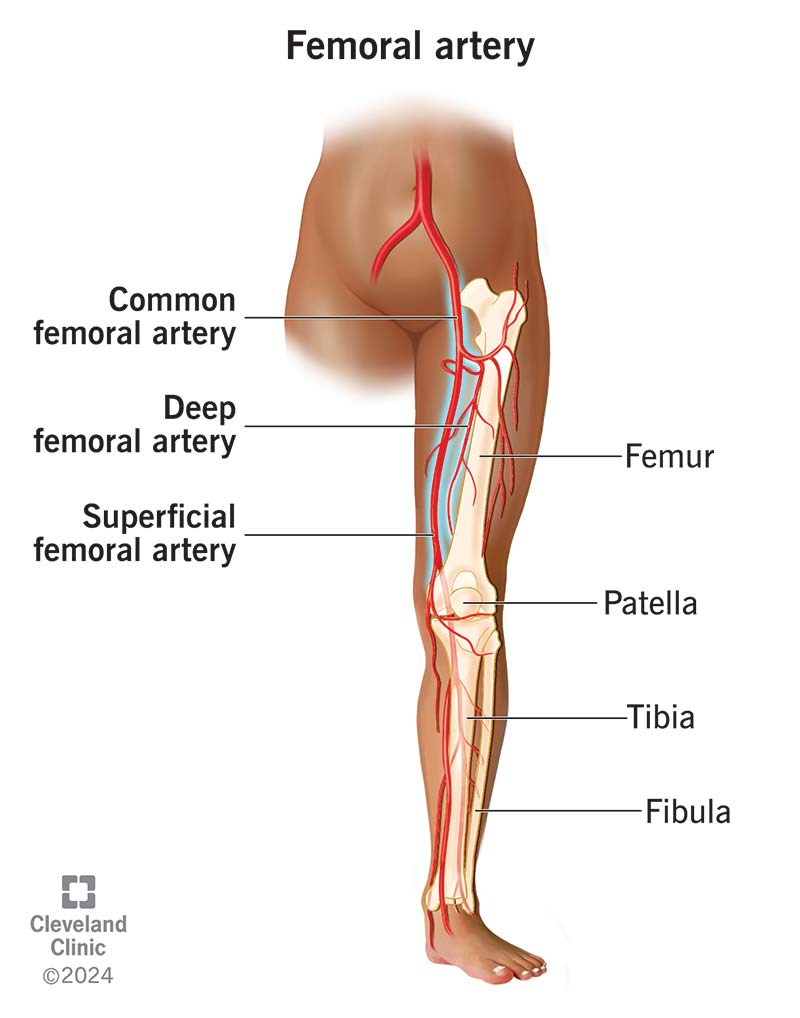
Question 4
Explain the role of capillaries in the circulatory system. (5 marks)
Mark Scheme:
Regulation of Blood Flow:
- Pericytes and smooth muscle surrounding capillaries help regulate blood flow and permeability based on the tissue’s needs. (1 mark)
Gas Exchange:
- Capillaries are the primary sites for the exchange of oxygen and carbon dioxide between blood and tissues. (1 mark)
Nutrient and Waste Exchange:
- They facilitate the diffusion of nutrients (e.g., glucose, amino acids) from the blood into tissues and the removal of waste products (e.g., urea) from tissues into the blood. (1 mark)
Thin Walls:
- Composed of a single layer of squamous epithelial cells (endothelium), allowing for efficient diffusion of substances. (1 mark)
Extensive Networks:
- Capillary beds form extensive networks within most body tissues, maximizing the surface area for exchange. (1 mark)
Question 5
Describe the function of the aorta and provide its key structural features. (5 marks)
Mark Scheme:
Descending Aorta:
- Travels downward through the thoracic and abdominal cavities, supplying blood to the body’s lower regions. (1 mark)
Function of the Aorta:
- The aorta is the largest artery in the body, responsible for distributing oxygenated blood from the left ventricle to all parts of the body. (1 mark)
Key Structural Features:
- Thick, Elastic Walls: Comprised of three layers (Tunica Intima, Tunica Media, Tunica Externa) with a high concentration of elastic fibers for flexibility. (1 mark)
Sections of the Aorta:
- Ascending Aorta: Extends from the heart upwards. (1 mark)
- Arch of the Aorta: Curves between the ascending and descending aorta, giving rise to major branches like the brachiocephalic trunk, left common carotid artery, and left subclavian artery. (1 mark)
Question 6
Explain the significance of semilunar valves in veins. (5 marks)
Mark Scheme:
Reduction of Venous Pressure:
- Preventing backflow helps in reducing venous pressure and maintaining steady blood flow within the circulatory system. (1 mark)
Valve Structure:
- Semilunar valves are flap-like structures located in veins, particularly in the limbs and the heart (e.g., heart’s ventricles). (1 mark)
Prevention of Backflow:
- They prevent the backflow of blood, ensuring it flows towards the heart and does not return when muscles relax or during body movements. (1 mark)
Maintaining Unidirectional Flow:
- By maintaining unidirectional blood flow, semilunar valves help in the efficient return of deoxygenated blood from the body to the heart. (1 mark)
Support During Venous Return:
- Especially important in limbs, where blood must travel against gravity; valves ensure blood is propelled upwards towards the heart. (1 mark)
Question 7
Describe the structure and function of venules in the circulatory system. (5 marks)
Mark Scheme:
Role in Immune Response:
- Venules can become post-capillary venules where white blood cells exit the bloodstream to reach tissues during immune responses. (1 mark)
Structural Characteristics:
- Venules are small veins that collect deoxygenated blood from capillary beds. (1 mark)
Wall Composition:
- They have thin walls consisting of endothelium and a minimal amount of smooth muscle. (1 mark)
Connection to Veins:
- Venules merge to form larger veins, facilitating the transport of blood towards the heart. (1 mark)
Function in Blood Flow:
- Serve as the bridging vessels between capillaries and veins, playing a crucial role in the consolidation of blood from multiple capillary networks. (1 mark)
Question 8
Explain how the structure of veins assists in the return of blood to the heart. (5 marks)
Mark Scheme:
Elasticity and Flexibility:
- While less elastic than arteries, veins can expand to accommodate varying blood volumes, aiding in the steady return of blood to the heart. (1 mark)
Semilunar Valves:
- Veins contain semilunar valves that prevent backflow, ensuring blood moves towards the heart. (1 mark)
Thin Walls:
- Veins have thinner walls and larger lumens compared to arteries, allowing them to hold a larger volume of blood with lower pressure. (1 mark)
Muscle Assistance:
- Veins located near muscles (e.g., in the legs) utilize muscle contractions to help propel blood back to the heart, a mechanism known as the muscle pump. (1 mark)
Proximity to the Body Surface:
- Superficial veins are closer to the body’s surface, making it easier for muscle movement to assist in blood flow. (1 mark)
Question 9
Describe the composition of blood and the function of each component. (5 marks)
Mark Scheme:
Other Components:
- May include electrolytes (e.g., sodium, potassium) and proteins (e.g., hemoglobin, albumin) essential for maintaining osmotic balance and transport functions. (1 mark)
Red Blood Cells (Erythrocytes):
- Function: Transport oxygen from the lungs to tissues and carbon dioxide back to the lungs. (1 mark)
White Blood Cells (Leukocytes):
- Function: Play roles in immune responses, defending the body against infections and foreign invaders. (1 mark)
Platelets (Thrombocytes):
- Function: Involved in blood clotting, helping to prevent excessive bleeding when injuries occur. (1 mark)
Plasma:
- Function: The liquid component that carries nutrients, hormones, waste products, proteins, and other solutes throughout the body. (1 mark)
Question 10
Explain how systemic and pulmonary circulation differ in terms of blood pressure and function. (6 marks)
Mark Scheme:
Definition of Systemic Circulation:
- Systemic circulation carries oxygenated blood from the left ventricle through the aorta to the body tissues and returns deoxygenated blood to the right atrium via the vena cava. (1 mark)
Definition of Pulmonary Circulation:
- Pulmonary circulation transports deoxygenated blood from the right ventricle through the pulmonary arteries to the lungs, and returns oxygenated blood to the left atrium via the pulmonary veins. (1 mark)
Blood Pressure Differences:
- Systemic Circulation: Operates under higher pressure to deliver blood throughout the entire body. (1 mark)
- Pulmonary Circulation: Functions under lower pressure to protect delicate lung capillaries during gas exchange. (1 mark)
Function in Oxygenation:
- Systemic Circulation: Delivers oxygen and nutrients to tissues and removes wastes.
- Pulmonary Circulation: Facilitates oxygenation of blood and removal of carbon dioxide. (1 mark)
Vessel Diameter and Resistance:
- Systemic Arteries and Veins: Have smaller diameters and higher resistance compared to pulmonary vessels. (1 mark)
Overall Role:
- The double circulatory system ensures efficient oxygen delivery and waste removal, supporting the high metabolic demands of mammals. (1 mark)